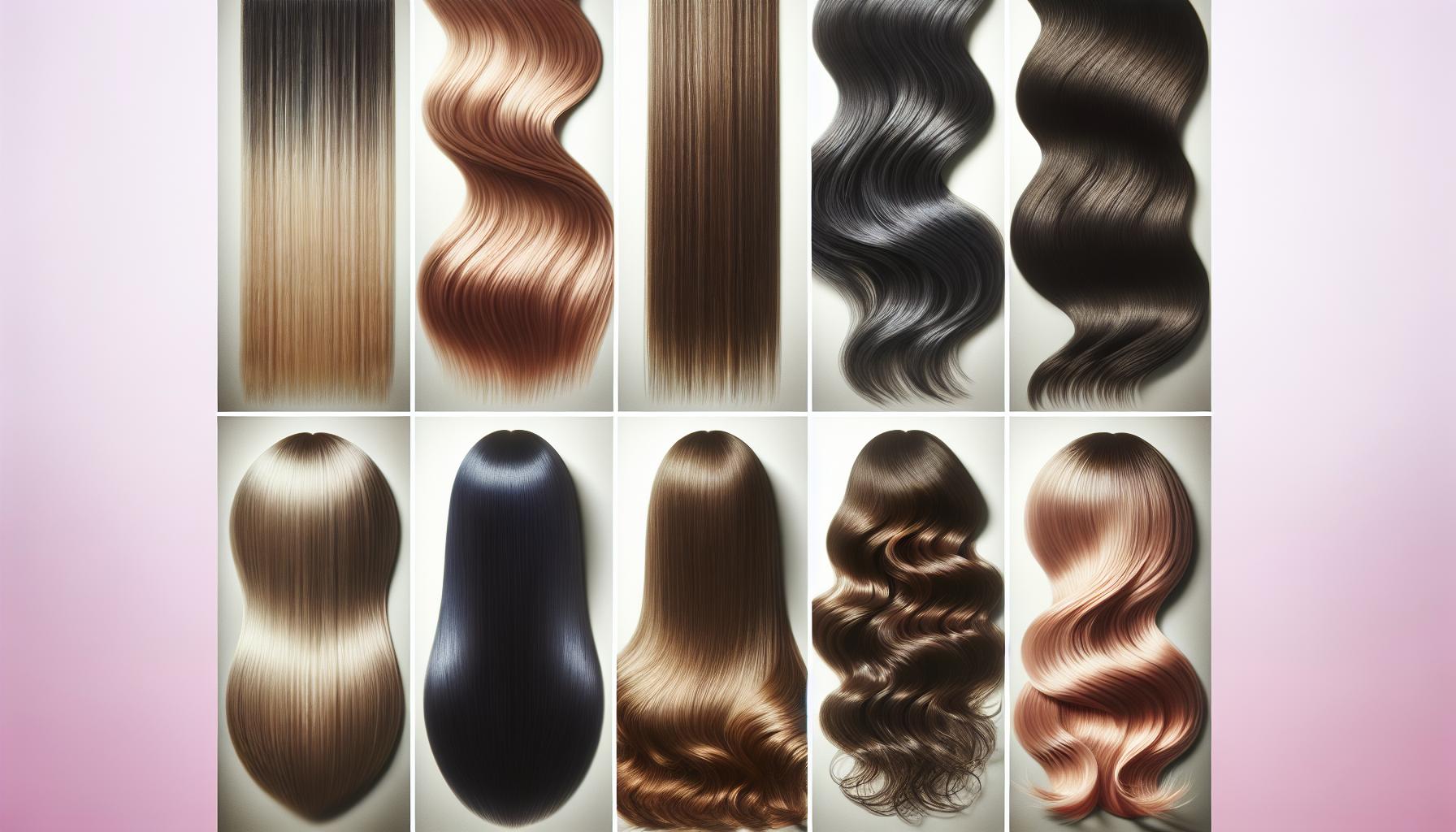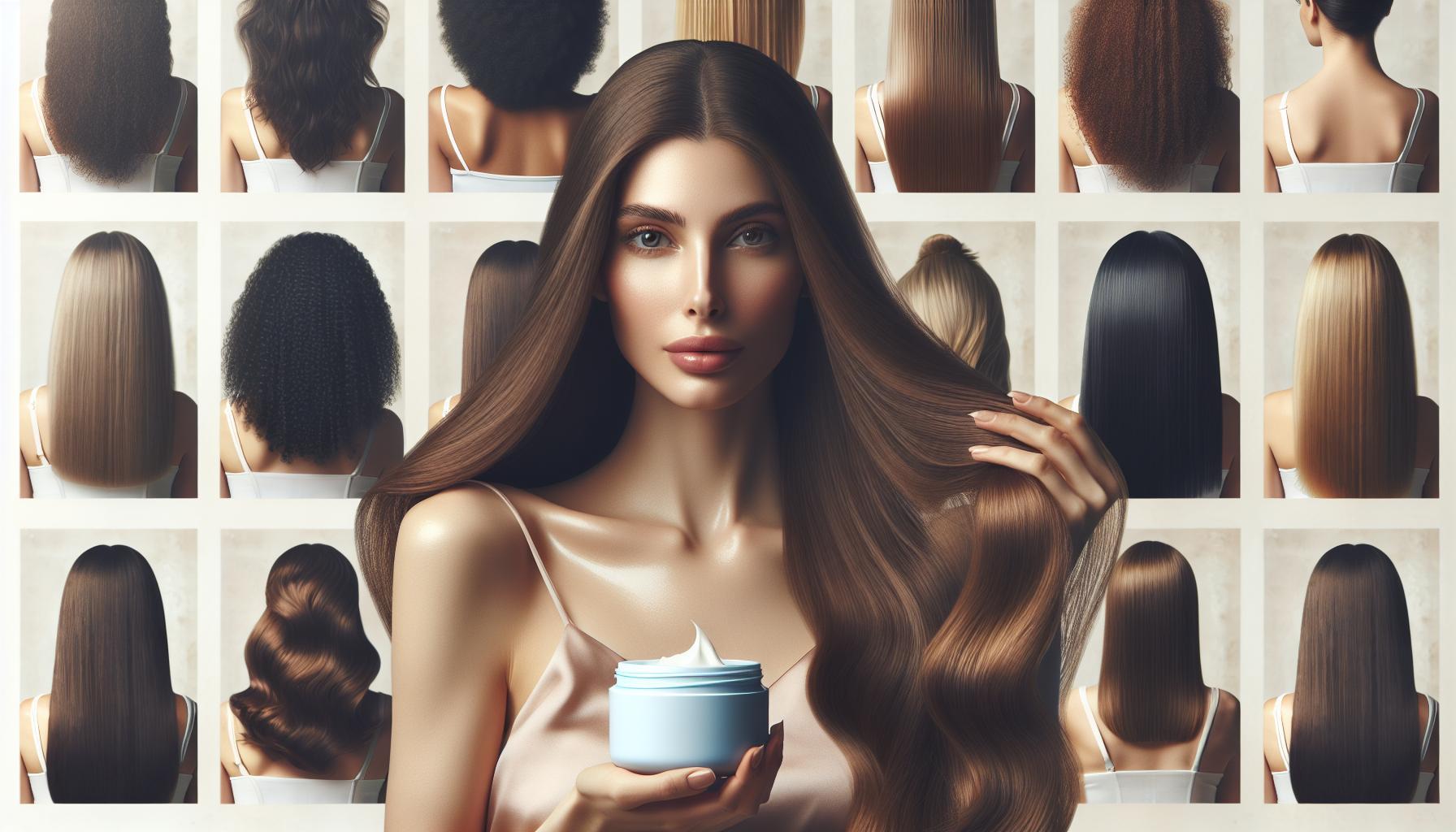Facing a hair follicle drug test can be daunting, especially with its ability to detect long-term substance use. Understanding effective ways to prepare for this testing method is crucial as it can impact employment opportunities and personal lives. By following proven strategies, you can improve your chances of passing and move forward with confidence.
Contents
- Understanding the Hair follicle Test: What It Is and How It Works
- Common Substances Tested: A Breakdown of What You Need to Know
- Preparation Steps: How to Get Ready Before the Test
- Detox methods: Do They Really Help in Passing the Test?
- Professional Advice: Tips from Experts on Hair Care and Test Results
- Myths and Facts: Debunking Common Misconceptions About Hair Tests
- Lifestyle Changes: Simple Adjustments to Support Healthy Hair
- Resources and Support: Where to Turn for Help and Guidance
- frequently Asked Questions
- What is a hair follicle test?
- How to Pass Hair Follicle Test: Essential Tips That Work?
- Can I use home remedies to pass a hair follicle test?
- How long does a hair follicle test detect drugs?
- Why does a hair drug test work?
- What substances can a hair follicle test detect?
- Is the hair follicle drug test painful?
- To Wrap It Up
Understanding the Hair follicle Test: What It Is and How It Works
The hair follicle drug test has gained popularity due to its ability to detect drug use over a longer period compared to conventional urine tests. This method can uncover drug use for up to 90 days,making it a critically important consideration for those facing drug screenings,particularly in employment contexts or legal situations. Understanding how this test works is crucial for anyone concerned about potential positive results and seeking effective ways to pass.
In essence, the hair follicle test operates by analyzing hair samples for drug metabolites, which are remnants of drugs that the body processes. when someone consumes drugs, these metabolites enter the bloodstream and gradually travel to hair follicles. As hair grows roughly half an inch per month, testers can determine drug use by examining the sections of hair corresponding to specific time frames. For effective testing, typically, a sample of about 1.5 inches of hair is needed, which provides a window into the previous 90 days of drug use.
Here’s a brief overview of the key elements related to the hair follicle test:
- Detection Window: Generally spans up to 90 days
- Sample Size: Typically a 1.5-inch strand cut close to the scalp
- Substances Detected: Commonly tested for opiates, cocaine, marijuana, and amphetamines
- Testing Process: Hair is collected, sent to a laboratory, and analyzed for drug metabolites
One critical aspect to consider is that hair tests cannot detect very recent drug use; typically, a sample must be collected at least five days after drug consumption for accurate results. This delay is due to the time it takes for metabolites to travel from the bloodstream into the hair follicle.By understanding the timeline and mechanism behind hair follicle testing, individuals can better strategize their approaches for passing these tests effectively if faced with one.
For those keen on ensuring a clean result in a hair follicle test, numerous strategies exist, from detox shampoos to lifestyle changes aimed at reducing drug metabolites in the system. Awareness and readiness can significantly enhance one’s chances of passing the test successfully.
Common Substances Tested: A Breakdown of What You Need to Know
When preparing for a hair follicle drug test, it’s crucial to understand the range of substances that can be detected and the implications for your testing outcomes. Hair follicle tests are known for their ability to identify drug use over an extended period, making them a preferred choice for many employers and legal institutions.Unlike urine tests, which can only track drug usage for a few days to weeks, hair tests can detect substance use for up to 90 days, capturing a more thorough history of drug consumption.
Substances Commonly Tested
A variety of substances are screened during a hair follicle test, each with unique detection windows. The most commonly tested substances include:
- Marijuana (THC): Detected for up to 90 days.
- Cocaine: Identifiable in hair for approximately 90 days.
- Opiates: This includes heroin and prescription painkillers,usually traceable for up to 90 days.
- Phencyclidine (PCP): Can be detected for a similar duration as other illicit drugs.
- Amphetamines: Detected for around 90 days, covering substances like methamphetamine.
Understanding these substances and their detection timelines is essential for anyone looking to navigate the complexities of drug testing. The hair follicle method captures drugs that have been absorbed into the bloodstream and incorporated into the hair follicle, allowing for an extended window of detection.
Implications of Detection
the ramifications of testing positive for these substances can be significant,ranging from job loss to legal consequences. Such as, a positive test result for marijuana can affect employment opportunities, especially in industries with strict drug-free policies. Moreover,because hair tests analyze a longer history of drug use,a single infraction can impact your prospects far beyond the timeframe detected,highlighting the importance of being informed and prepared.
understanding the substances tested in a hair follicle drug test is vital for anyone who may be subject to such evaluations. This knowledge empowers individuals to make informed decisions regarding their substance use and to strategize effectively about how to pass a hair follicle test. Being educated about the testing process and the substances involved can significantly influence outcomes in both personal and professional realms.
Preparation Steps: How to Get Ready Before the Test
To effectively prepare for a hair follicle drug test, understanding the testing process and implementing smart strategies can significantly enhance your chances of passing. Hair follicle tests can detect drug use for up to 90 days, making thorough preparation crucial. Here are essential steps you can take to ensure you’re ready for the examination.
Stop Drug Use Immediately
The first and most critical step is to cease any drug use as soon as possible. Depending on the substance, it can take weeks or even months for drugs to leave your system entirely. Aim to abstain from all drug use for at least 90 days prior to the test for the best results.
Consider Hair Detox Options
Utilizing a high-quality detox shampoo can significantly help in removing drug traces from your hair. Here are two highly regarded products to consider:
- Old Style Aloe Toxin Rid Shampoo: This shampoo is frequently enough recommended for its ability to cleanse the hair of toxins effectively.
- Zydot Ultra Clean Shampoo: This is another popular option that aims to remove drug residues and impurities from the hair.
Follow the instructions thoroughly to maximize the effectiveness of these shampoos.
Maintain Healthy Hair
In addition to using detox shampoos, it’s beneficial to maintain healthy hair conditions. This includes keeping your hair clean and avoiding excessive styling products,which can impede the detox process. Ensure you wash and condition your hair regularly.
Consider Home Testing
Before your official test, you might want to perform a home drug test kit to gauge your chances of passing. These kits can help you assess the level of toxins still present in your hair and can be purchased online or at local pharmacies. If you find that you’re still testing positive, revisit the detox methods mentioned and allow more time before your test.
By combining these preparation strategies, you create a solid foundation for passing the hair follicle drug test. Whether through lifestyle changes or utilizing detox products, thorough preparation can make a significant difference in the outcome.
Detox methods: Do They Really Help in Passing the Test?
When facing the anxiety of an upcoming hair follicle drug test, many individuals turn to detox methods with the hope that these techniques can cleanse their system and improve their chances of passing.However,the effectiveness of these methods can vary significantly based on several factors,including the type of substances consumed,the frequency of use,and the time elapsed since last use. Understanding how to navigate these detox strategies is crucial for those seeking to successfully pass a hair follicle test.
One common approach is the use of detox shampoos, which are specially formulated to remove drug metabolites from the hair shaft. While some users report success with these products, it’s important to note that results can be inconsistent. Detox shampoos typically work best when used in conjunction with other methods and are most effective when applied as directed in the days leading up to the test. Popular options include detoxifying cleansers designed to penetrate the hair and eliminate toxins, although experts suggest that these should not be solely relied upon.
Additionally, some people resort to home remedies, such as rinsing hair with vinegar or baking soda, believing these concoctions can purge drug residues. While anecdotal evidence exists regarding these methods,scientific backing is limited. It’s essential to approach these remedies with caution, as they may not yield the desired outcome and could potentially damage hair when used excessively.
For a more thorough strategy,individuals may consider combining detox shampoos with dietary changes and increased hydration. Consuming a balanced diet rich in fruits, vegetables, and water can definitely help the body’s natural detoxification processes. Engaging in regular physical activity can also promote overall health and potentially expedite the elimination of toxins through sweat. Ultimately,while detox methods can play a role in preparing for a hair follicle test,relying on them alone is seldom sufficient. A comprehensive approach, including abstaining from drug use for an appropriate time frame before the test, remains the most reliable way to achieve a negative result.
while various detox methods are available to assist with hair follicle drug tests, their efficacy can vary widely. A combination of detox shampoos, dietary modifications, and increased hydration appears to yield the best results, though the most effective strategy is always to avoid drug use well in advance of the testing date.
Professional Advice: Tips from Experts on Hair Care and Test Results
In the realm of drug testing, hair follicle tests stand out due to their ability to detect substance use over an extended period, usually up to 90 days. Understanding how to prepare for and potentially influence the results of these tests is crucial for anyone concerned about their outcomes. Experts in hair care and drug testing provide valuable insights that can help you navigate this challenging situation effectively.
Understanding Hair Follicle Tests
Hair follicle tests are designed to screen for various substances,including illicit drugs and certain medications. Unlike urine tests, which typically assess recent use, hair tests analyze the hair shaft for traces of drugs that have stayed locked in the hair structure over time [[1](https://www.healthline.com/health/hair-follicle-drug-test)]. This method tests hair cut close to the scalp, ensuring that the sample reflects your drug use history as accurately as possible.
Practical Tips to Improve Hair Health and Test Results
While no method can guarantee a passing result if substances are present, there are strategies to help prepare your hair for testing:
- Maintain Clean Hair: Regular cleaning with detox shampoos designed for this purpose can help minimize the presence of drug residues. Look for products that specifically mention their effectiveness against hair follicle tests.
- Limit hair Products: Reduce the use of styling products like gels or sprays that can build up in your hair, making it tougher to clean thoroughly before the test.
- Consider hair Length: shorter hair can be beneficial since a majority of hair drug tests analyze the last 1.5 inches of hair closest to the scalp. If possible, trim your hair to reduce the risk of old drug metabolites being detected.
Consulting Experts
It’s advisable to talk to professionals who specialize in hair analysis or drug testing. They can offer tailored guidance based on your unique situation, including detoxing techniques and the expected accuracy of certain products. In addition,they can provide information about the timeline for hair growth and how that might play into your results.
Ultimately, while knowing how to pass a hair follicle test can be daunting, understanding the nuances of hair care and seeking professional advice can significantly enhance your preparedness and confidence.The journey may involve both immediate and long-term strategies, depending on your drug use history and the timing of the test.
Myths and Facts: Debunking Common Misconceptions About Hair Tests
Understanding the nuances of hair follicle drug testing is crucial for anyone facing this type of examination. Many misconceptions circulate about what these tests can detect and how they operate. Such as, one prevalent myth is that hair follicle tests can reliably uncover the presence of every drug under the sun. In reality, these tests typically focus on specific substances, including opiates, cannabis, cocaine, amphetamines, and PCP, varying slightly by the laboratory performing the test [[2]](https://www.gddlaw.com/2016/08/29/6-facts-myths-hair-follicle-drug-tests/).
Another common belief is that hair testing is a foolproof method for checking drug use. While hair tests have higher accuracy compared to other forms of testing, they are not immune to false negatives or positives. Factors such as the length and condition of the hair can influence results. Drug metabolites can enter the hair shaft through sweat and sebaceous glands, complicating the testing process [[3]](https://www.drugtestpanels.com/blogs/articles/hair-drug-test-myths-and-facts).
Additionally, many people think that hair tests can identify drug use for an unlimited time frame.This is misleading; a standard hair analysis of 1.5 inches can typically detect usage up to three months prior. Longer hair may store drugs for extended periods, but this can also depend on the hair’s growth rate and other individual factors [[1]](https://www.health-street.net/blog-drug-testing/hair-drug-testing-facts-and-myths/).
For those looking for ways to prepare for an upcoming test, understanding these myths is the first step. Proper hair care, maintaining a healthy scalp, and considering special detox products can play a significant role in your preparation. Still,the effectiveness of these detox methods frequently enough varies,and relying solely on them without understanding the science behind hair testing may led to unexpected results.
Lifestyle Changes: Simple Adjustments to Support Healthy Hair
Maintaining healthy hair is not solely dependent on the products you use; it also involves making lifestyle adjustments that contribute to overall hair health. Just like with any other aspect of personal care, the way you approach your daily routines can significantly influence the vitality of your hair. For anyone looking to support healthier hair, especially in the context of preparing for a hair follicle test, adopting certain lifestyle changes can be incredibly beneficial.
Nutrition: Fueling Your Hair
One of the cornerstone habits to embrace is a balanced diet. Incorporating foods rich in vitamins and minerals can enhance hair strength and growth. Focus on:
- proteins: hair is primarily made of protein, so including lean meats, fish, eggs, and beans can fortify your strands.
- Omega-3 Fatty Acids: found in fish like salmon, walnuts, and flaxseeds, these fats support scalp health and promote hair shine.
- Vitamins A and C: Carrots, spinach, and citrus fruits improve sebum production and help prevent dryness.
- Zinc and Iron: These minerals, prevalent in nuts and leafy greens, are crucial for preventing hair loss.
Scalp Care: The Foundation of Hair Health
Regular scalp massages not only feel good but also stimulate blood circulation, which is essential for delivering nutrients to the hair follicles. Consider adding a nightly routine where you gently massage your scalp using natural oils, such as coconut or olive oil, which can provide hydration and nourishment to your hair roots.
Hydration: Drink Up for healthy Strands
Staying hydrated is essential for maintaining the moisture balance of your hair.Dehydration can lead to brittle and weak hair, making it more susceptible to breakage. Aim to drink at least eight glasses of water a day, and you may notice a remarkable improvement in your hair’s overall health and texture.
Stress Management: The Hidden Hair Loss Culprit
High stress levels can lead to hair loss and other hair-related issues. Incorporating stress-relief techniques such as yoga, meditation, or regular exercise can have a positive impact not only on your emotional well-being but also on the health of your hair. Develop a routine that includes physical activity as it promotes better circulation and reduces cortisol levels, which can harm your hair follicles.
By integrating these simple yet effective lifestyle changes, you lay the groundwork for healthier hair that may help you navigate the complexities of passing a hair follicle test. Remember, consistency is key, and these adjustments can lead to long-lasting benefits beyond just ensuring your hair passes a test.
Resources and Support: Where to Turn for Help and Guidance
in navigating the complexities of hair follicle drug testing, understanding the available resources and support systems can significantly impact your approach. Seeking guidance can empower individuals facing these challenges to make informed decisions and find effective strategies. Whether you are looking for advice on how to pass hair follicle tests or seeking help from professionals, there are many avenues to explore.
Professional Counseling and Support Groups
Engaging with professionals who specialize in substance use can provide much-needed insight and support. Consider the following resources:
- Treatment centers: Many clinics offer counseling services tailored to those undergoing drug tests. They can provide personalized strategies based on your situation.
- Support Groups: Connecting with others through support groups can be incredibly beneficial. Sharing experiences and hearing from those who have successfully navigated hair follicle testing can offer motivation and practical tips.
educational Materials
Equipping yourself with knowledge about hair follicle tests can be a vital step in preparation.
- Webinars and Workshops: Look for online seminars that focus on drug testing and recovery. These can provide up-to-date information on new testing technologies and methods.
- Articles and Guides: Leverage credible sources that explore effective methods for passing hair follicle tests. Many articles break down test mechanisms and offer actionable strategies.
Online Forums and Communities
The digital age makes it easier than ever to connect with others who might potentially be experiencing similar situations.
- Discussion Boards: Platforms like Reddit have dedicated communities discussing drug tests where you can share concerns and ask for advice.
- Social Media Groups: Facebook and other networks host groups centered around recovery and sobriety that can be a source of encouragement and practical tips.
Accessing these resources not only equips you with essential knowledge regarding how to pass hair follicle tests but also creates a supportive network that fosters understanding and recovery. Remember, you are not alone on this journey, and guidance is always available.
frequently Asked Questions
What is a hair follicle test?
A hair follicle test is a method used to detect drug use by analyzing hair samples for substances. This test can reveal drug use from as far back as 90 days.
The process involves cutting hair close to the scalp, typically around 1.5 inches, and testing it for traces of specific drugs. This method is considered reliable because hair grows slowly, and substances are metabolized and deposited in the hair shaft over time. For more information about what substances can be detected, check our detailed guide.
How to Pass Hair Follicle Test: Essential Tips That Work?
To pass a hair follicle test, consider using detox shampoos specifically designed to cleanse hair of drug residues. Following instructions carefully can significantly improve your chances of passing.
Detox shampoos work by removing embedded toxins in the hair shaft. However,it’s essential to start the cleansing process at least a few days before the test for the best results. Additionally, maintaining a healthy diet and staying hydrated can also help your body detoxify naturally.
Can I use home remedies to pass a hair follicle test?
While some claim that home remedies like vinegar or baking soda can definitely help cleanse hair, their effectiveness is largely unproven.Many users find limited success with these methods.
It’s frequently enough recommended to rely on proven detox shampoos rather,as they are formulated specifically for this purpose. If you’re considering home remedies, ensure they won’t damage your hair while trying to remove drug residues.
How long does a hair follicle test detect drugs?
A hair follicle test can detect drug use typically within the last 90 days. This time frame varies based on hair length and growth rate.
For instance, about 1.5 inches of hair represents approximately 90 days of hair growth.Consequently, the longer the hair, the longer the detection window. Understanding this timeline is crucial for those preparing for an upcoming test.
Why does a hair drug test work?
A hair drug test works by analyzing drug metabolites deposited in the hair shaft as hair grows. Unlike urine tests, this method provides a longer detection window.
Drugs enter the bloodstream and can be absorbed by hair follicles. As hair grows, the metabolites become trapped in the hair, allowing for a comprehensive ancient analysis of drug use. This unique characteristic makes hair follicle testing a preferred choice for employers.
What substances can a hair follicle test detect?
A hair follicle test can detect a wide range of substances, including marijuana, cocaine, opioids, and amphetamines, among others.
The specific substances tested often depend on the type of screening program being used.Many tests evaluate for several common drugs simultaneously, which is why it’s essential to understand what your test includes ahead of time.
Is the hair follicle drug test painful?
No, a hair follicle drug test is generally painless. It typically involves cutting hair close to the scalp, without pulling or tugging.
The collection process is speedy, and most people do not experience any discomfort. If you have concerns about the process, communicating with the professional conducting the test can definitely help ease your mind.
To Wrap It Up
navigating the complexities of hair follicle drug tests can be daunting, but armed with the right knowledge and techniques, you can improve your chances of success.We’ve explored essential strategies, from the timing of last exposure to the use of effective cleansing methods like vinegar and salicylic acid, which have shown promise in helping to detoxify hair follicles. Understanding the science behind how drugs are deposited in hair helps demystify the testing process,empowering you with actionable insights. Remember, every individual’s situation is unique, so consider these tips in the context of your personal circumstances. For those seeking further support or specific product recommendations, we encourage you to dive deeper into resources or connect with professionals who can offer tailored advice. Your hair health is important, and with the right approach, you can make informed choices that lead to positive outcomes.









